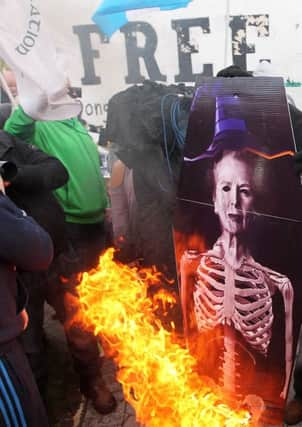PSNI cleared ofexcessive force during Thatcher riot


An investigation at the Police Ombudsman’s Office, which has just concluded, has found that there was insufficient evidence to uphold the allegation, which was made after a youth was arrested, during disturbances in the Bogside area.
Over 20 petrol bombs were thrown towards police vehicles and the Fountain area during the rioting in April 2013 just four months into Londonderry UK City of Culture 2013.
Advertisement
Hide AdAdvertisement
Hide AdMr Callaghan said: “We strive to set high standards and any use of force should be necessary, proportionate and appropriate to the circumstances facing police officers, who often placed in a difficult and challenging situation in order to keep people safe.
“We welcome the fact that the Police Ombudsman’s office has found that police had not used excessive force in this arrest.”
The Police Ombudsman’s Office concluded police did not use too much force during the arrest of a youth in connection with a suspected petrol bomb incident.
The youth said his arrest had been unlawful as he had done nothing wrong before “about 16” police officers came running towards him, two of whom grabbed him and threw him against a wall.
Advertisement
Hide AdAdvertisement
Hide AdHe said he was held there while officers radioed his details to a police aircraft overhead, and was then arrested.
As he was being led to a police Land Rover, he said an officer put his hand on his neck and kept nipping it, and that while in the vehicle an officer was verbally abusive towards him.
He was placed in police custody but later released unconditionally.
A Police Ombudsman investigator interviewed officers who had been involved in the incident, which happened in Co. Derry/Londonderry in April 2013. She also reviewed relevant police records, including aerial video footage captured from the police aircraft.
Advertisement
Hide AdAdvertisement
Hide AdThe footage showed that the youth’s clothing had been similar to that worn by young people suspected of possessing petrol bombs nearby. He was stopped by police as he was walking away from the same area.
The officer who made the arrest said he had done so on the order of a supervising officer, who in turn said he had acted on the basis of information supplied to him by crew in the police aircraft.
Having viewed the aerial footage, the investigator concluded that there had been sufficient grounds for police to arrest the youth.
She also concluded that the footage did not support the youth’s account of police having used excessive force during the arrest, nor an account of the incident provided by the youth’s father.
Advertisement
Hide AdAdvertisement
Hide AdThe youth’s brother – who was said to have overheard the alleged abusive comments in the police Land Rover – did not respond to requests to provide a statement. The officer involved denied having done so, and the investigator concluded that there was insufficient evidence to uphold the allegation.